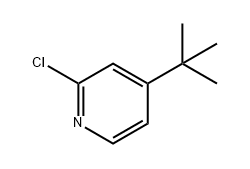Functionalizing pyridine derivatives is a cornerstone in modern synthetic chemistry, and 4-(tert-butyl)-2-chloropyridine is one of the most useful intermediates for building complex molecules. As someone who has worked with pyridine chemistry for years, I’ve seen how this compound can open the door to countless applications, from drug discovery to crop protection chemistry. In this guide, I will share practical insights into its properties, uses, functionalization steps, and best practices for handling it safely — so that even a beginner can approach it with confidence.
Overview of 4-(tert-Butyl)-2-Chloropyridine Properties

4-(tert-butyl)-2-chloropyridine (CAS 81167-60-4) is a substituted pyridine featuring a bulky tert-butyl group at the 4-position and a chlorine atom at the 2-position. This combination gives the molecule unique electronic and steric properties that make it an excellent starting point for further derivatization.
The presence of the chlorine atom activates the 2-position toward nucleophilic substitution, allowing easy introduction of amines, thiols, or other nucleophiles. The tert-butyl group enhances the compound’s lipophilicity and stability, which can be beneficial in medicinal chemistry programs aiming to optimize pharmacokinetic properties. It is typically a colorless to pale yellow liquid or crystalline solid, with moderate volatility and good solubility in most organic solvents such as dichloromethane, THF, and acetonitrile.
Applications in Pharmaceutical and Agrochemical Synthesis
This compound is widely used as a building block in the synthesis of pharmaceuticals, agrochemicals, and specialty chemicals. In medicinal chemistry, 4-(tert-butyl)-2-chloropyridine is commonly employed to introduce a functionalized pyridine ring into drug candidates, contributing to improved metabolic stability and binding affinity.
In agrochemical research, it serves as a precursor to herbicides, fungicides, and insecticides that rely on heteroaromatic cores for bioactivity. The ease of substitution at the 2-position allows for rapid generation of libraries of analogs during lead optimization programs. Beyond pharma and ag-chem, this intermediate also finds use in the development of functional materials and ligands for catalysis.
Step-by-Step Functionalization Procedures
The most common functionalization of 4-(tert-butyl)-2-chloropyridine is nucleophilic aromatic substitution (SNAr) of the chlorine atom. Based on my experience, here is a simplified yet effective workflow:
Dissolve the Substrate: Place the required amount of 4-(tert-butyl)-2-chloropyridine in a dry reaction vessel and dissolve it in an anhydrous polar aprotic solvent such as DMF, THF, or acetonitrile.
Add the Nucleophile: Introduce the chosen nucleophile — for example, an amine, thiol, or alkoxide — under inert atmosphere if sensitive to moisture.
Control the Temperature: Heat the reaction mixture gently (often between 50–100 °C) to promote substitution while minimizing side reactions.
Monitor the Reaction: Use TLC, HPLC, or LC-MS to track the conversion. Stopping the reaction at the right time ensures good yield and purity.
Work-Up and Purification: Quench the reaction with water, extract with an organic solvent, and purify by column chromatography or recrystallization if needed.
Careful control of reaction conditions is crucial. Overheating or using too strong a base may lead to undesired side reactions, while insufficient activation might leave starting material unreacted.
How to Store and Handle 4-(tert-Butyl)-2-Chloropyridine Safely
Like most halogenated pyridines, 4-(tert-butyl)-2-chloropyridine should be handled with care. Work in a well-ventilated fume hood to avoid inhalation of vapors. Wear gloves, goggles, and lab coat to protect against skin and eye contact. The compound should be stored in a tightly closed container, in a cool, dry place, away from strong bases or oxidizing agents that could trigger side reactions.
Spills can be absorbed with inert material such as vermiculite and disposed of according to local regulations. After handling, always wash hands thoroughly to avoid irritation from trace residues.
4-(tert-butyl)-2-chloropyridine is a powerful and versatile intermediate for anyone working with pyridine chemistry. Understanding its properties, mastering its functionalization steps, and following good storage and safety practices will allow you to take full advantage of its potential in pharmaceuticals, agrochemicals, and beyond. Whether you are a beginner or an experienced chemist, a well-planned approach can help you achieve high yields, cleaner reactions, and safer workflows.



